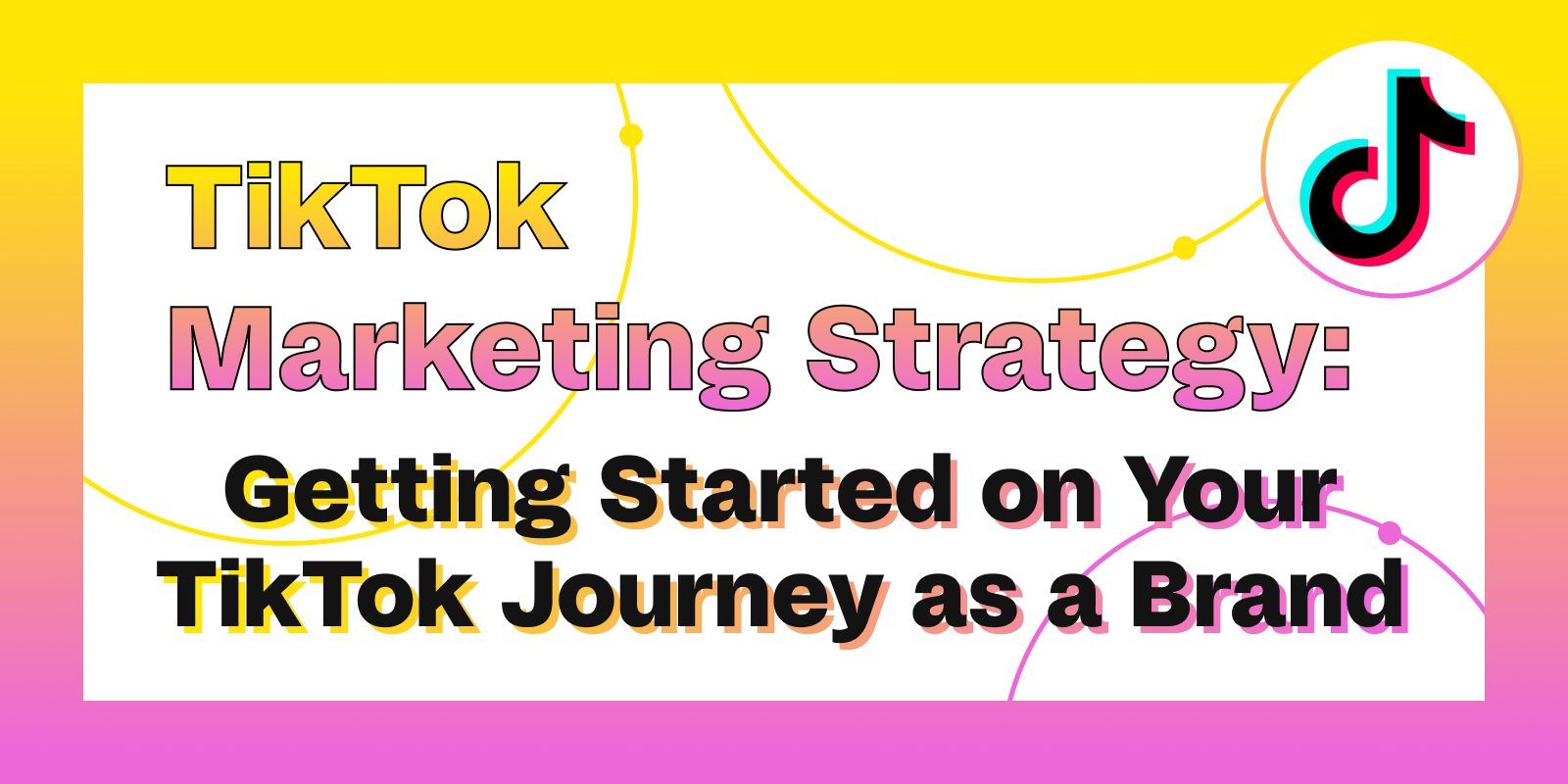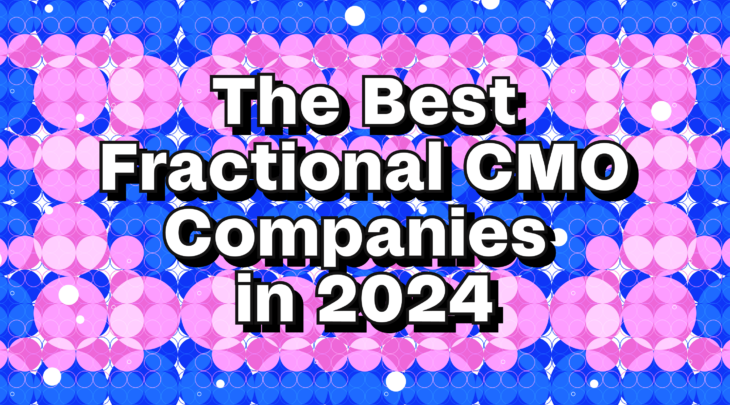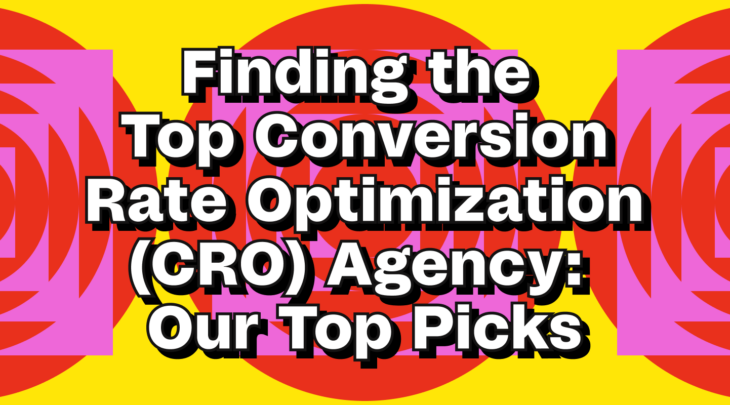“Can we be like Duolingo on TikTok?”
“Can we work with creators to grow on TikTok?”
“How can we go viral on TikTok?”
If you have been wondering about any of the questions above, you are not the only one. Oftentimes, these are the starting questions brands ask themselves when they consider TikTok as a channel. Here’s why it’s not a good idea to think about the video app through the lens of these questions.
TikTok should not be regarded as a standalone channel — or a “trendy” channel brands need to be on because it’s widely discussed at this moment in time. Instead, TikTok needs to be an extension of your existing content strategy, consistent with the brand’s values, key offerings, and other channels. Do you have a newsletter? A presence on other social media platforms? A paid media strategy? Just as you’d ensure brand and messaging consistency across all these channels, so should you add TikTok as an additional touchpoint through which your audience can connect with you and gain value from the content you share. Of course, the content on TikTok will match in its execution to the unique needs and requirements of the platform — but the key here is to think of it more holistically as another element of a consistent marketing strategy.
Additionally, it’s important to understand that, just like any other content channel, TikTok also requires appropriate resourcing in order to maintain consistency and quality of content. Just like a social media manager would monitor a brand’s presence across social platforms, or a dedicated writer would author the newsletter or blog posts, the same way TikTok requires a dedicated content creator (or creators) who is a true storyteller at heart, passionate about the brand and its offerings, and working on a consistent output of a few videos a day.
Whether you go down the in-house creator route, partner with an expert TikTok agency partner like NoGood, or collaborate with micro-influencers to source UGC content (check out our UGC guide for more information), there are many ways to dedicate the necessary resources to this channel to see promising results.
But enough on the introduction — let’s get to the actionable insights you are here for.
Without further ado, here’s NoGood’s tried and true framework for a sustainable, long-term growth strategy for TikTok.
TL;DR:
- Set your goals.
- Understand your competitive landscape.
- Get clear on your brand’s identity.
- Develop content “buckets.”
- Experiment with video formats.
- Spark the top organic performers.
- Analyze the data and insights.
- Learn, rinse, repeat.
- Bonus: a hot take on going viral and how to repurpose TikTok videos for a multi-channel strategy
1. Set clear, measurable goals for your future strategy.
Whether you envision TikTok as a channel for a strong organic presence or a conversion-driven performance campaign, it’s important to define what you hope to achieve on the channel and how it aligns with your ultimate brand objectives.
Are you trying to achieve product-market fit? Increase brand awareness and recall? Build a community? Drive conversions? It’s important to align TikTok as an additional channel in your overall marketing strategy and how it works symbiotically with the rest of the channel mix to help you achieve measurable results.
2. Understand the landscape you are entering.
Every successful content strategy, be it on TikTok or any other platform, starts with research. It’s important to understand the landscape you are entering, the key players that dominate the space, and the cultural context in which you will be operating. Here is a brief checklist of things you should collect information on as you prepare for your official TikTok launch:
Conduct competitive research.
Who are your direct and indirect competitors that are currently on the platform? How much credibility do they have on TikTok (followers, likes, median views, comments, etc.)? What’s already working for them? What isn’t?
Pro tip: we like using the GRIN Engagement Rate Calculator to understand the relationship some of our competitors have built with their communities.
Make sure to also pay attention to the conversations that these brands have with their communities. What are some topics discussed in the comment section? What’s the audience’s stance on the brand’s videos? These can serve as great thought starters for your content strategy, sourced directly from the communities you’d like to tap into.
Identify accounts you admire on TikTok.
These don’t necessarily have to be your direct competitors necessarily; instead, seek accounts that speak to you in terms of their content style, brand tone and voice, and positioning on TikTok. Think of it this way: which brands or creators, in their own industry or vertical, have successfully curated a strong social media persona and how have they connected with their respective communities?
As you are conducting your research, pay close attention to characteristics such as video editing style, delivery, as well as use of trends, native TikTok video editing features, and formats.
Whether it’s Duolingo’s unhinged mascot or Beis’s use of user-generated content, there are so many brands that have developed their unique ways to approach TikTok — it’s your job to observe the winning strategies and adopt them.
For example, Crispy Fantasy, an up-and-coming healthy cereal brand (and arguably Magic Spoon’s competitor) unlocked growth in a very unconventional way — by sharing their story of moving from failure to failure but persevering in a series of videos. In stark contrast to a more typical approach of positive growth and success stories, big announcements, and milestones other brands share on TikTok, Crispy Fantasy leaned into full transparency and started building a community through authentic content that’s engaging, real, and human.
Identify winning concepts you can lean into.
At this stage, having identified the competitors and non-competitor brands you want to formulate your strategy after, start looking for common threads in the content topics, delivery styles, editing, and trends you’d like to experiment with.
If you are a DTC beauty brand, some popular video formats include how-to tutorials, before-and-after shots, side-by-side product comparisons, the more recent “clean girl aesthetic,” the no-makeup-makeup looks, get-ready-with-me-for-a-specific-occasion videos — and the list goes on. The Bobbi Brown TikTok account is a prime example of a wide variety of videos ranging from tips and tutorials to makeup education.
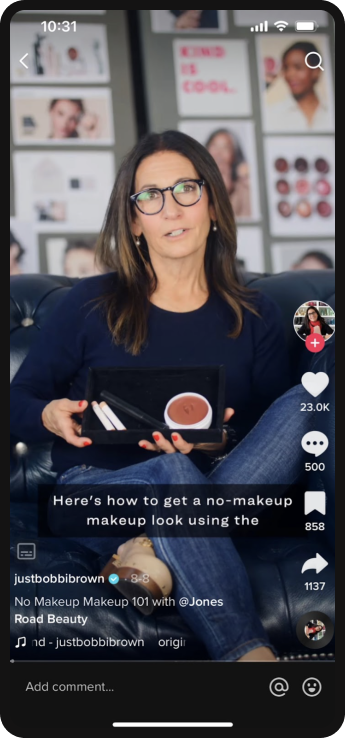
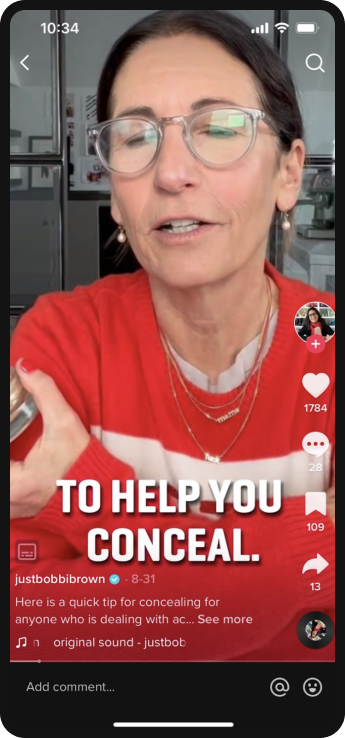
If you are a SaaS brand, some impactful video formats include product use cases, tutorials, template sharing, UI/UX greenscreens, and showcases — again, this list is by no means exhaustive. Notion’s TikTok, for example, features a variety of videos that focus around specific features, how they apply to different needs (personal or professional), and examples of how to use them.
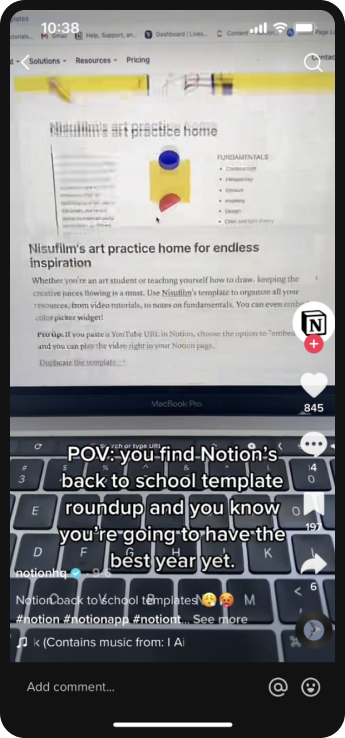
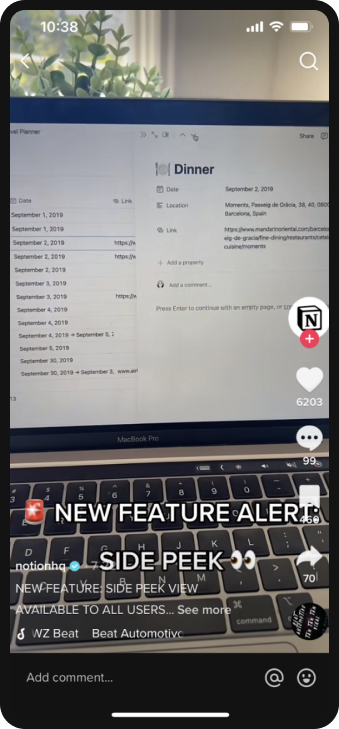
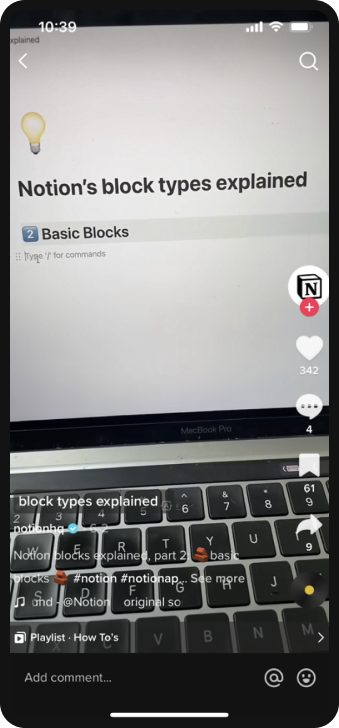
3. Get extra clear on your brand pillars.
After evaluating the competitive landscape and identifying the winning formula for other players in the space, it’s time to get back to your brand basics. At this stage, it’s important to focus on yourself and identify the key value propositions and characteristics that define you as a brand. Remember how we touched on the larger (shared) values that your brand should build a community around? This is where it’s important to know what you stand for as a brand — and what exact benefits you offer to your consumer base.
A few key points you should have crystal clear alignment on are:
- Your brand story: how did your brand come to life? What was the motivation behind creating this brand?
- The “why” behind your brand: what is the larger mission that drives your brand? Is there a larger cause you stand for?
- Your unique differentiators (or the “what” and the “how”): whether it’s a set of key products (as a DTC brand), features (as a SaaS brand), or approach, identify 2-3 factors that set you apart from other brands in the market and why the consumer should choose your brand over competitors.
- Your customer personas (or the “who”): who are you talking to? Whose concerns would you like to address? Who will benefit from your offering the most? And of course, who can become your loyal advocates?
You should have the answers to these questions already as part of your brand guidelines and identity — but if not, use this as a chance to get back to the roots of your brand and re-align. This exercise is not TikTok-specific — it should inform the rest of your content strategy across other channels to ensure brand and messaging consistency.
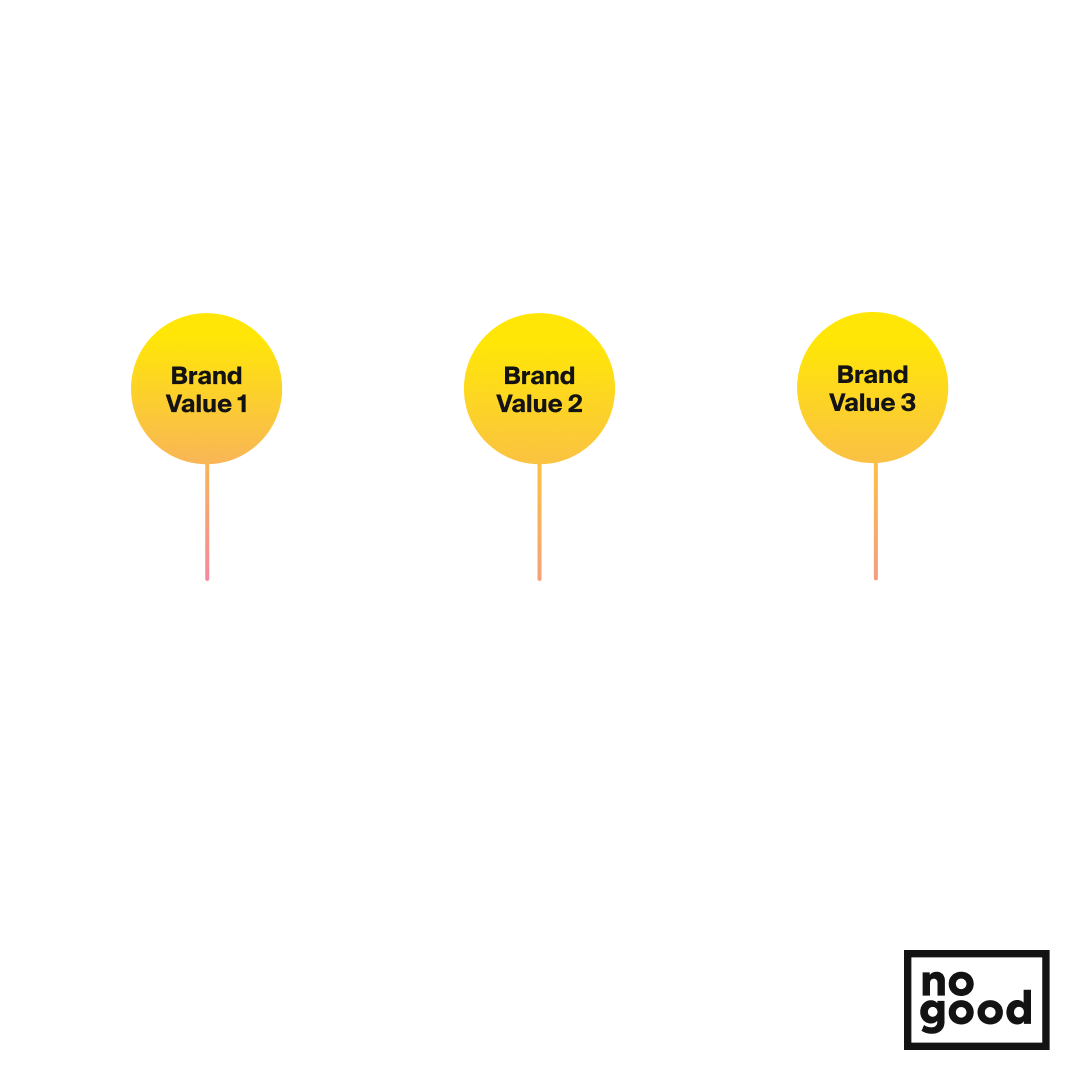
4. Create content “buckets” based on your pillars to experiment with positioning on TikTok.
After identifying your brand pillars, start categorizing them into content “buckets”, or macro themes, that you’ll be drawing from for video ideas. The content buckets will build on the specific values, offerings, and differentiators that you have identified in step 2, ensuring brand consistency and alignment.
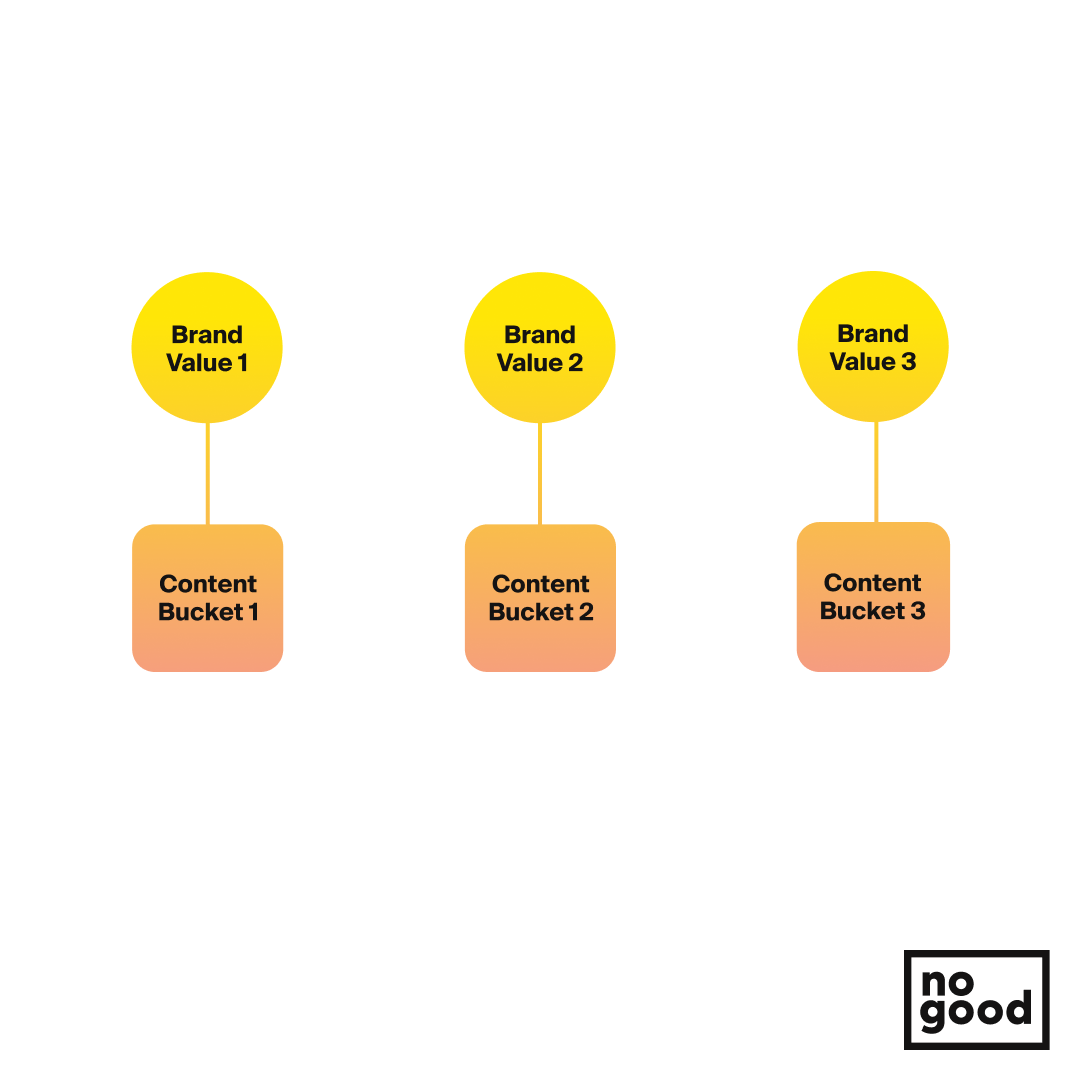
For example, as a DTC beauty brand, you might want to have categories that include (but are not limited to):
- product highlights (showcases your exact product benefits)
- The production story behind the brand and the products (draws from your brand values)
- educational content such as how-to videos, use cases or tips (draws from the “how” and “why” of your brand)
- competitor comparison such as highlighting differentiating qualities of your products (draws from your differentiation)
Or, as another example, as a SaaS brand, you can develop a content strategy that draws from the following content buckets:
- feature-specific content, i.e. the “did you know this exists?” approach (shows the benefit of your products/features)
- product use cases such as “how-to” content, educational content, walkthroughs (shows your differentiation)
- user characters in action such as a small business owner looking for a productivity tool, a type A planner who loves organization tools, etc. (showcases benefits that meet specific customer persona concerns)
For all of the above — and any brand really — company culture is also a very powerful content “bucket” to draw from in order to lean into a more human persona and add more relevance to it. It’s also a great way to contribute to your overall efforts in building a strong persona on the platform by showcasing authentic, engaging content centered around company culture.
Let’s look at two brand examples that illustrate this step in action.
Going back to the Bobbi Brown example, you can observe the sheer variety of the content buckets the brand pulls from — and how consistent is Bobbi’s presence as the representative of her own brand as well. The brand’s content draws from every single sample bucket outlined above, covering the basics from why and how certain products were created, what problem they aim to solve, and how they work in action.
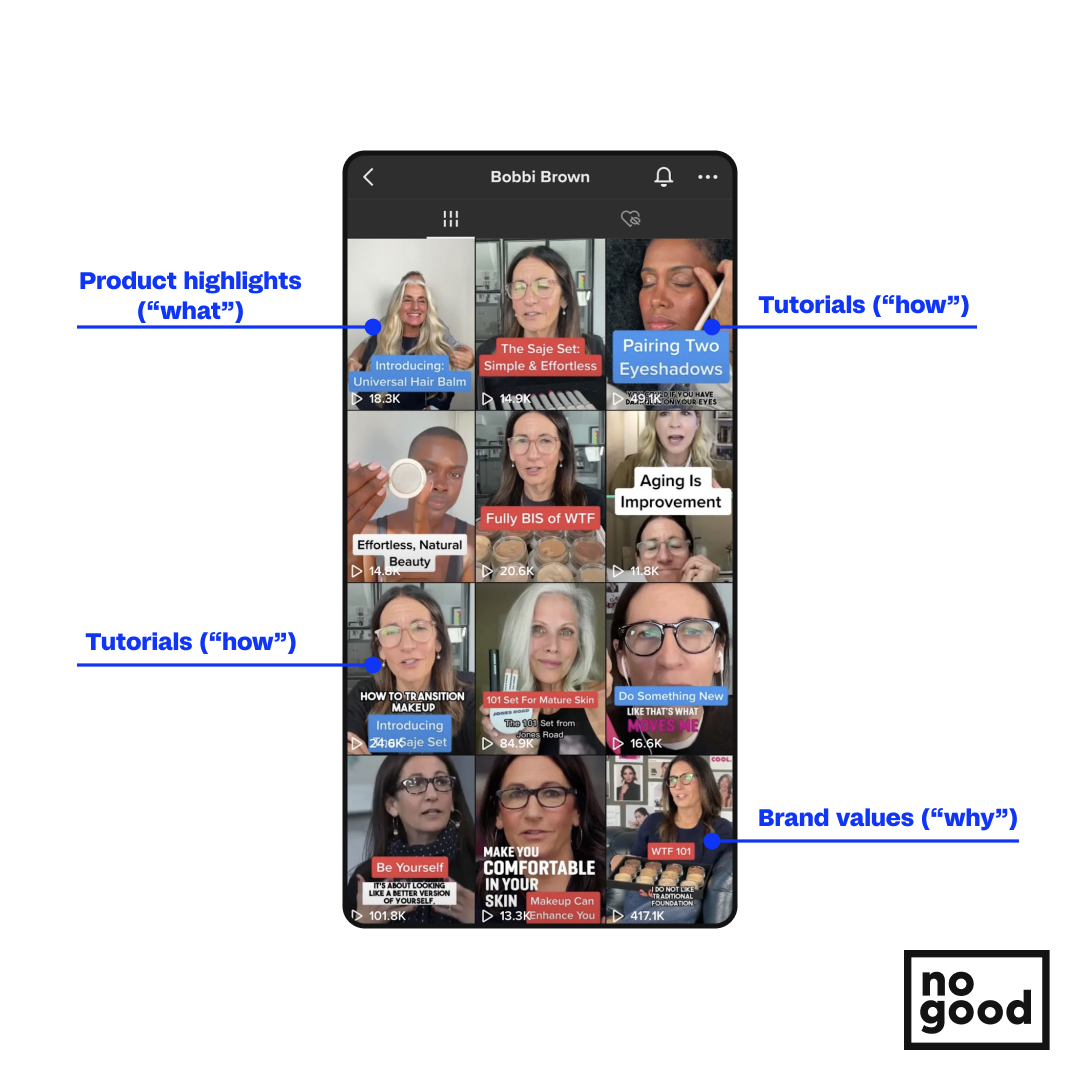
Let’s look at Notion as a further example of the content buckets in action. Notion has leaned fully into the content “buckets” that encompass their startup culture and the human faces behind the brand, as well as taking a feature- and product-specific approach to continuously educate their user base on the capabilities that the tool offers and how it can alleviate their organizational pains on a day-to-day basis. They also leverage the culture that has developed around the product through their humorous “character” videos that showcase how Notion users think, as well as featuring “inside jokes” that colder audiences would want to be part of.
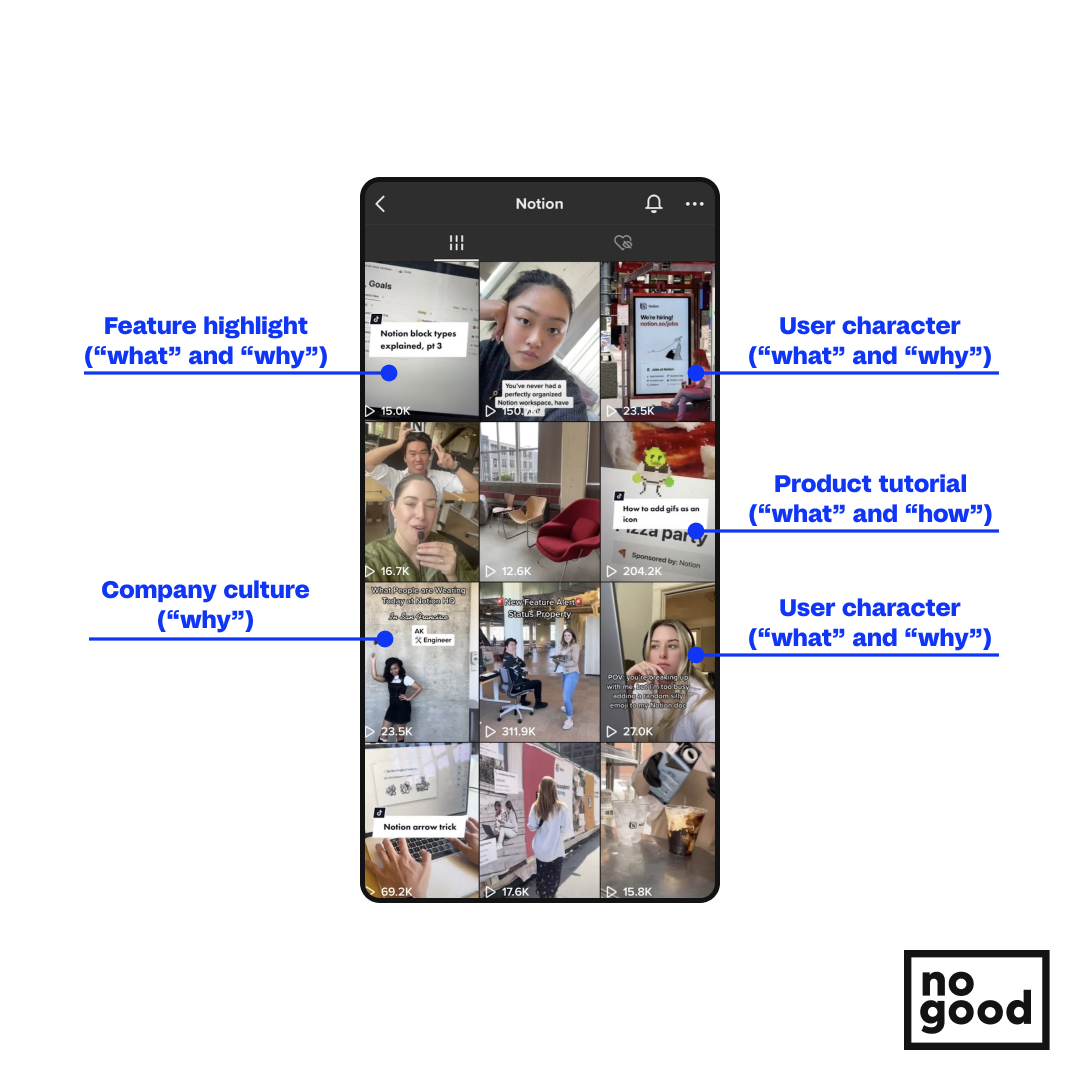
What this exercise does is, it allows you to kick off experimentation on a macro level in order to see what messaging resonates with the audience, channel the efforts into what works, and ultimately identify the most optimal positioning on TikTok. At NoGood, we value cross-channel learnings that allow for continuous refinement of a brand’s positioning. From this perspective, your TikTok experiments provide valuable insights that you can leverage as starting points in developing content strategies across other channels — from organic social (Instagram Reels, YouTube Shorts, etc.) and paid media (PPC, social ads) to editorial (blog, newsletter, etc.).
Note: An important caveat for TikTok as a platform is the need for consistency. While learnings and results happen very quickly on the platform, keep in mind that you are in for a long game — and it takes patience and dedication to succeed. Keep in mind that the saturation of content on TikTok (for your niche or the platform at large), means a larger volume of output will be necessary to achieve better results, in a shorter period of time.
Our (tried and true) recommendation here at NoGood is to post at least 1-3 times a day for the first 30 days drawing from the content “buckets” — if possible, keep up the cadence for 90 days. The short-form video format and the focus on the raw, authentic feel of the content allow us to strike a balance between quality and quantity unlike other channels, so take advantage of the fact that imperfection goes a long way on this platform.
5. Experiment with delivery and different video formats based on the winning content “buckets.”
Okay, what have you accomplished so far? You’ve analyzed the competitive space, aligned it with your brand’s identity and positioning, and outlined a content strategy that builds on your brand overall. The next step is to take your experimentation to a more granular level and test multiple variations of videos within the winning content “buckets.”
Remember the observations from your competitive analysis? The notes you took on the use of trends, editing style, and content delivery that worked? Here’s exactly where these observations come in: after identifying the content “buckets” it’s time to experiment with multiple variations, ideas, and delivery styles under each to continue testing winning formats for your brand.
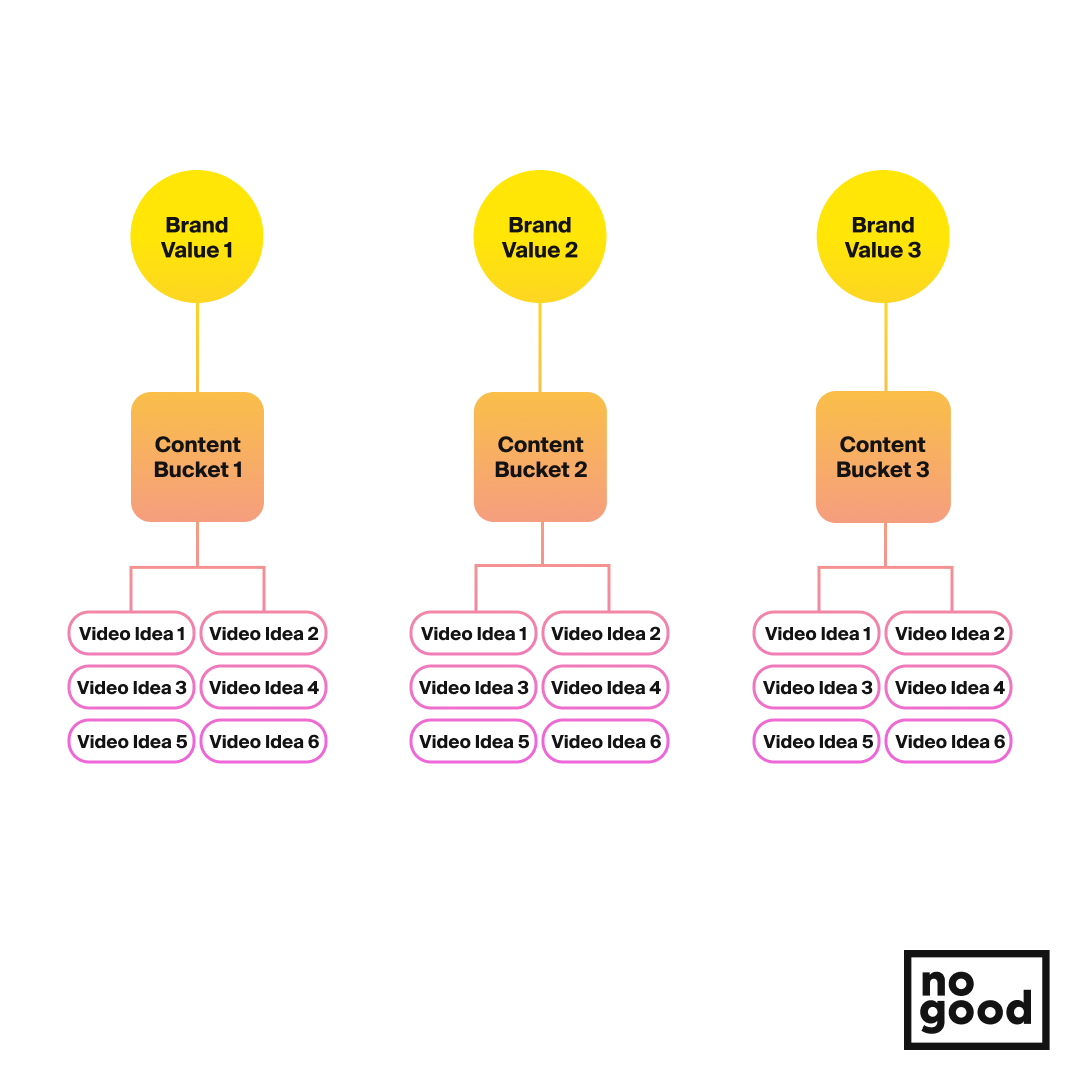
There are a few experiments you can run at this stage:
- Leaning into trends in delivering the content you have in mind in a humorous, engaging format
- Introducing reactive content and tying your videos into larger cultural conversations and events discussed on the platform
- Testing a variety of hooks and introductions to maintain audience engagement
- Testing the length of your videos (15-30 seconds vs. 1-3 mins)
- Playing with a variety of text overlays within the platform to visually emphasize your point
- Leveraging TikTok’s in-app editing capabilities and content formats such as greenscreen, stories, filters, comment responses, stitches and duets (more on this later), etc.
A major benefit of validating your ideas and doubling down on what performs is the opportunity to create series and playlists. Have you ever seen brands and creators have videos that say “Part 4” and get curious about what parts 1-3 were about? This is a direct outcome of building on the momentum a successful video unlocked, and running micro-experiments (or variations) to take the testing a step further.
After identifying the most successful content “buckets”, you can also group videos that draw from each pillar into playlists (think: albums), giving the audience the option to browse through your content more efficiently and view the videos that pique their interest the most.
Finally, don’t think of your TikTok content as a “monologue” — instead, make it a dialogue.
TikTok might be a discovery platform meant for consumption and have certain small limitations for community-building, but it’s key to create a conversation with your community however possible. Remember the comment replies, stitches, and duets I mentioned earlier? These are TikTok’s native features that enable co-creation — meaning, a conversational approach to producing content.
For brands, these features open a door to building relationships directly with your current and potential customers, engaging with creators in a similar space, and participating in conversations more actively. For example, comment replies allow you to respond to direct contributions from your community members; they also provide new opportunities for micro-experimentation or serializing content.
You can also leverage duets and stitches to respond to videos that current or potential consumers of your brand have posted or to build on the momentum of a viral video.
6. Spark video content that performs organically if you are considering paid advertising on TikTok.
Historically, organic efforts and paid strategies in the larger digital marketing ecosystem have been considered completely separate practices. Organic social presence fell under the branding practice, while paid media fell under the performance practice.
TikTok has completely challenged this notion of treating both as separate entities — and it’s very much in light of the larger push for authentic, UGC-inspired content in the industry in general. For their TikTok marketing strategy to thrive, brands need to think of a strong organic presence as a prerequisite to a successful paid strategy (more on that later). This is largely due to TikTok’s Spark Ads format, which is a native amplification of a video asset posted organically to the brand’s account. Unlike “boosted posts” on Instagram, Spark Ads have a higher impact at any stage of the funnel and can leverage organically posted content that has already resonated with the audience.
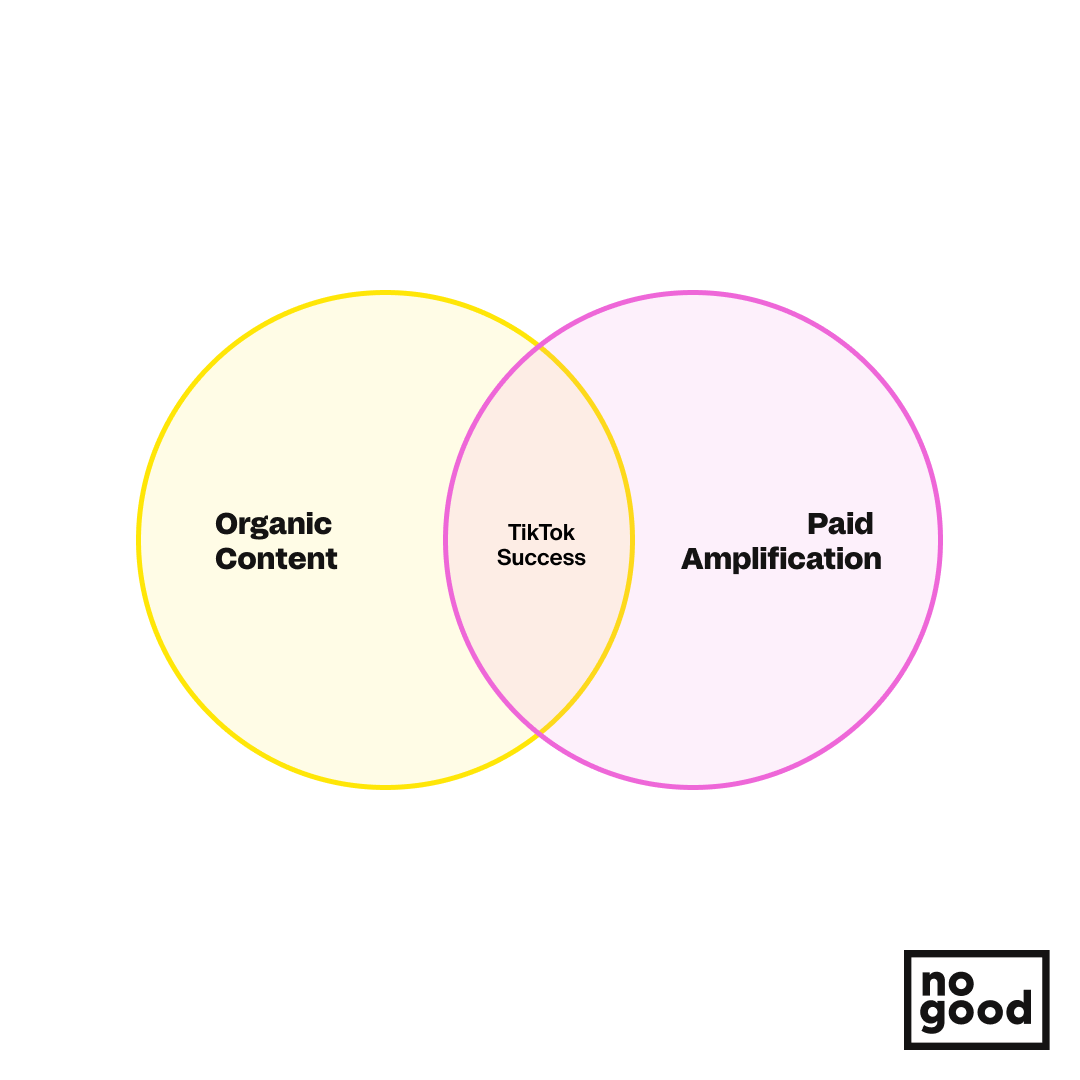
On TikTok (and by extension, other paid social channels now as well), creative can make or break your strategy, which is why marketers are now challenged to think harder about the quality, purpose, and how convincing an organic video is before layering paid media to spark it.
Now, let’s tie this back into your overall TikTok marketing strategy. At this point, you know what positioning resonates with your audience and what video formats perform organically — so it’s a good time to start introducing paid campaigns. Going organic-first with your TikTok strategy gives you the opportunity to test the resonance of your creative prior to investing ad dollars into it.
Here’s where the Spark Ads come in. As a native ad format (and due to the fact that the creative is based on an originally organic video), Spark Ads amplify a piece of content with a lot more efficiency and without alienating the audience with overly promotional messaging. Not only does a Spark Ad improve the performance of the individual content piece, but it also pushes your content to a pre-determined target audience in order to drive results at each funnel stage.
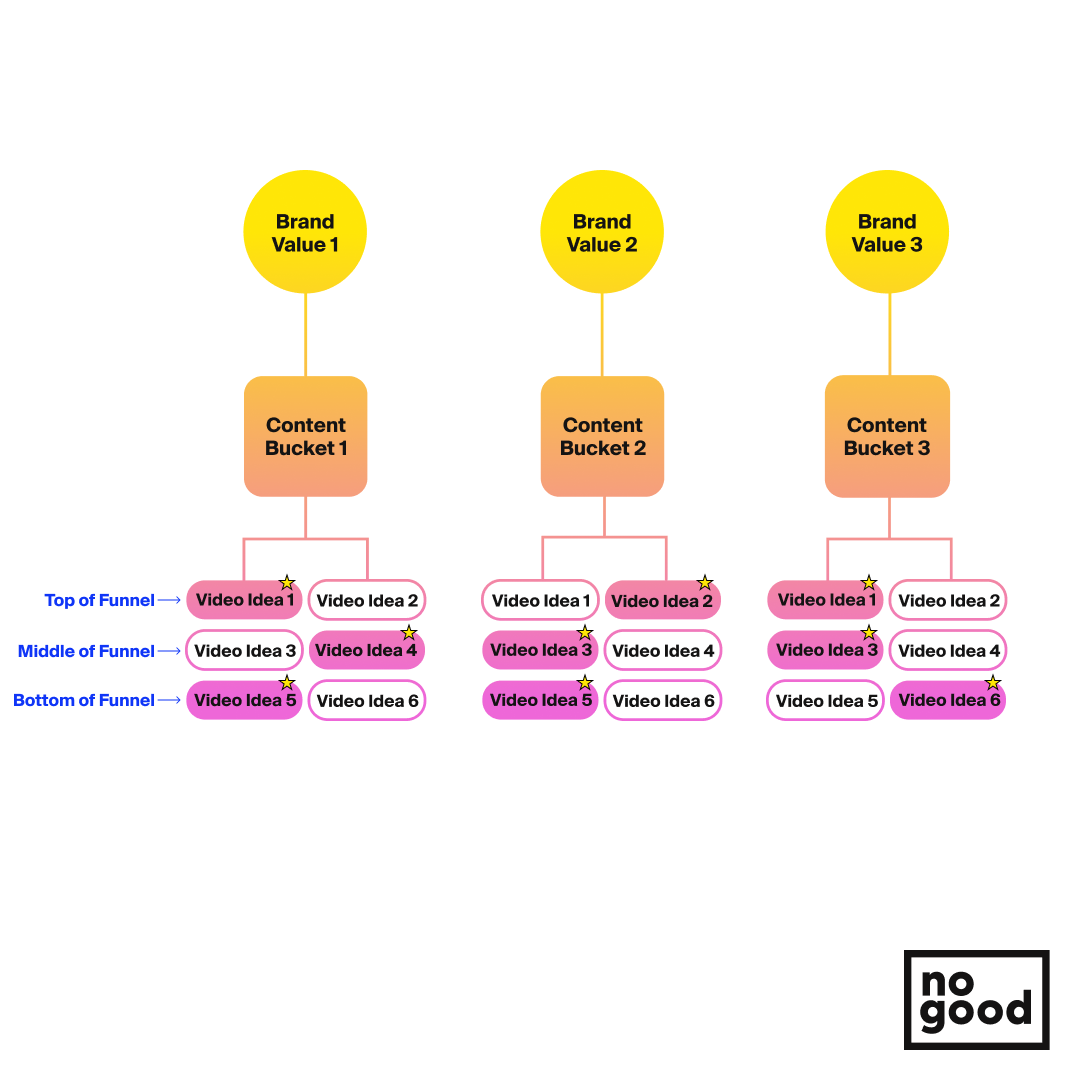
In terms of timing — if you are wondering when you can introduce paid advertising through Spark Ads — our best recommendation is to have at least 7-10 organic videos on your account before launching your campaigns. Why you might ask? For two reasons:
- taking the initial week to kick off your organic experimentation will give you the initial data to identify the winning videos;
- because Spark Ads are directly tied to your organic account on TikTok, it’s important to establish an initial presence to inspire brand trust from your audience.
If you are interested in diving deeper into TikTok ads, our TikTok advertising guide is designed to break down TikTok from a paid advertising standpoint.
7. Analyze organic and paid performance.
You’ve made it. Your content buckets are set, you are posting videos consistently, and you may have already introduced a paid campaign on the platform. Congratulations, your TikTok marketing strategy is in motion! Now it’s time to understand how to evaluate your performance (paid or organic) to collect valuable insights.
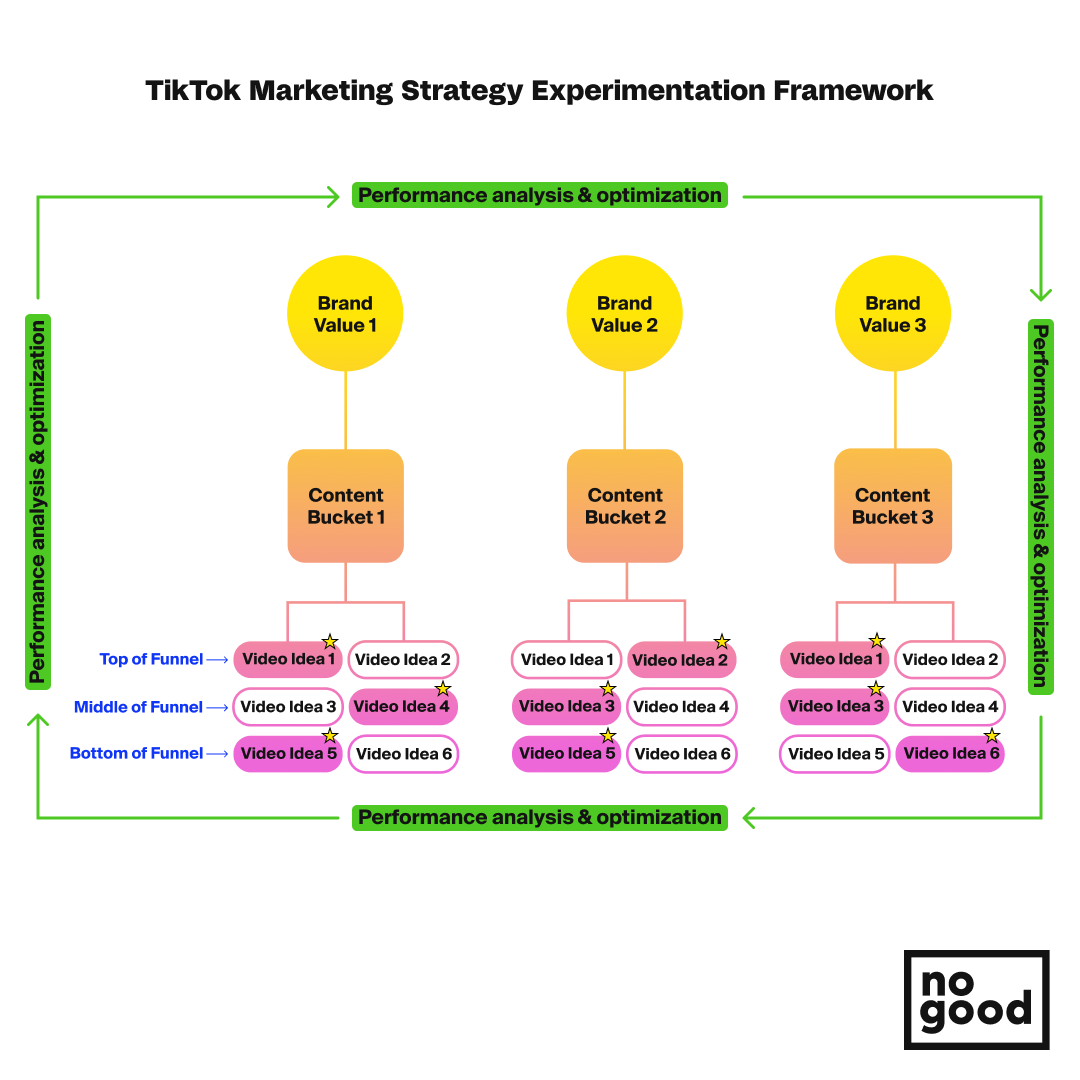
Organically, there are a few metrics that allow you to measure your progress on TikTok. You have your follower count, views, likes (cumulative and per video), comments, shares, bookmarks, and view time. Keep in mind: do not look at each metric individually — on their own, they won’t tell you the full story. Rather, each of these metrics tells you a different story, so it’s important to look at all of them holistically to measure the audience interest and the organic performance of your content.
For example, looking at the follower count only won’t give you a good picture of your audience’s engagement if your views are not high. Similarly, looking at views without factoring in engagement (likes, comments, bookmarks) won’t help you understand whether your audience recognizes the true value of the content you share. View time will allow you to understand whether your content was engaging enough to maintain audience attention throughout, while a view count only would give you an idea of how many people the video was shown to.
The initial tests you run with your content will help you determine your own benchmarks for what good performance is and how to set more ambitious goals you can achieve through continuous experimentation.
When it comes to paid campaigns, the metrics you’ll want to keep an eye on will depend on your goals, your vertical, and your business model (just like you would with any other paid social channel). Some key indicators we recommend focusing on are the CAC and CTR, which can give you a good idea of how many people took an action and converted. Keep in mind that TikTok does not track your campaign’s customer acquisition cost (CAC) — so make sure you make the calculation yourself and continuously measure the channel’s profitability.
When using Spark Ads, make sure to note the organic performance results of the video prior to sparking it in order to really understand how to guide your choice in the assets you’ll boost next. As with the organic metrics, each of these measures allows you to understand performance from a variety of angles — and each can tell a story unique to your vertical, business model, as well as funnel stage your asset is shown at.
Here are some further metrics you can use to measure your performance, depending on the campaign type and funnel stage:
- Impressions, CPM: how many times was your ad shown to your audience, and what’s the cost per 1,000 impressions?
- CPV: how much does a video view of 2 seconds and more cost on average?
- Average watch time vs. Completions: How long on average does your audience watch your video vs. how many times did the audience complete 25%, 50%, 75%, or 100% of the ad?
- Cost per action (CPA): How much does your conversion cost (depending on the action you are optimizing for)?
- Return on ad spend (ROAS): How much revenue did the campaign generate in proportion to the media spend?
8. Experiment, learn, rinse & repeat.
Et voilá! You’ve just successfully built an experimentation flywheel that allows you to refine your brand positioning (tone, voice, identity, values) through macro-experiments, develop a unique and recognizable delivery style through micro-experiments, and launch paid campaigns with a higher ROI. This approach allows you to unlock your niche, build your community ground up, and continuously optimize your content to perform better.
We recommend checking in on performance on a weekly, monthly, and quarterly basis to keep a close eye on the patterns and to shift your strategy when necessary — because TikTok as a platform evolves quickly, and so should you as a resident brand.
A note on virality
If you expect me to say, “Make sure your goal is to make every video go viral,” then you are wrong. Sort of.
Of course, virality is key to explosive growth. We even have an entire guide on how to quantify virality and include it in your growth strategy. But that’s the thing — the growth you achieve is explosive, short-term, and momentary. Instead, what the approach outlined above allows for is to build sustainable momentum on the platform and unlock longevity on a platform that’s notorious for transiency.
In order to unlock such sustainability, think of your content in 2 categories:
- Content meant for reach
- Content meant for engagement.
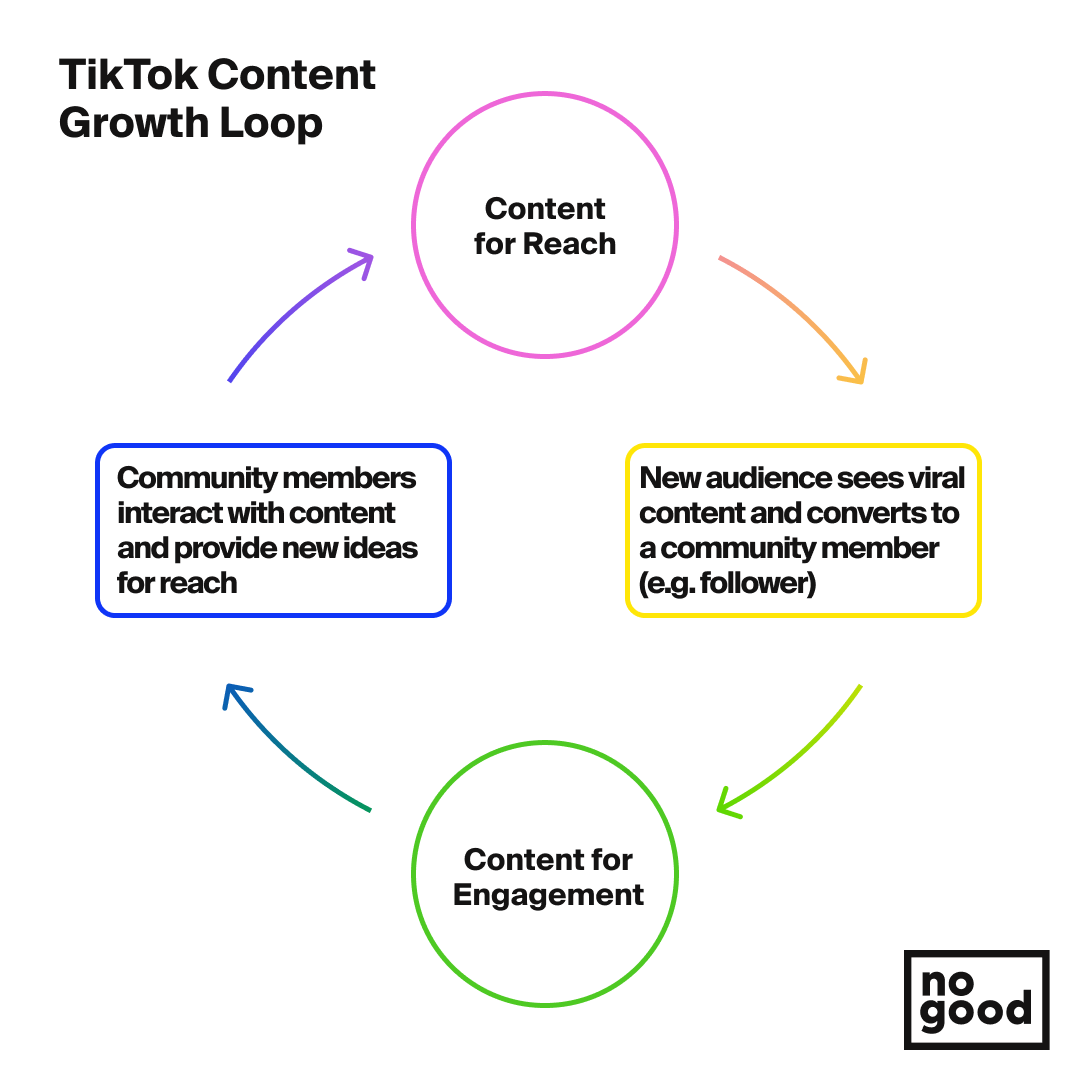
Category 1 — which will include your viral videos — is meant to bring in new audiences that are interested in the value you offer and would like to see more of your content. Essentially, it’s your discovery mechanism that allows you to cast a wider net and grow your audience.
Category 2, on the other hand, is meant for the people who already know, follow or believe in you as a brand. These videos are meant to spark conversation, deepen relationships with your loyal customers and strengthen your community.
The key to a successful content strategy is a balance between both. Of course, you want to aspire for higher views and virality. However, there is importance to videos that might not unlock a sky-high number of views, but they achieve the response you need for your community (think: comments, reshares, bookmarks) that help you with the ideation of more content.
Call it your own growth loop, if you will.
Creating a Multi-Channel Content Flywheel
Because TikTok’s native content is, essentially, UGC-style content, this creates a unique opportunity for brands to repurpose winning video content across multiple channels and run experimentation on more than one platform at a time.
This is especially true as short-form, UGC video becomes the best performing content format for organic and paid efforts. We’ve observed social media giants prioritizing short-form video across the board — think Instagram (and now Facebook) introducing Reels, YouTube introducing Shorts, the list goes on to include Snapchat, Pinterest, and more social platforms.
Combined with the fact that the majority of modern cultural conversations are starting on TikTok, it allows brands to create a vault of videos that are on trend, in tune with culture, and that can be repurposed across other platforms (paid and organic) for testing purposes.
As you go through each step and begin identifying the winning videos that resonated with your audience, download and repurpose them across other platforms and paid campaigns to continue your experimentation process. At NoGood, we prefer using musicaldown.com or repurpose.io to download videos without the watermark.
Keep in mind that the content repository is simply a good starting point for building your strategy across other social channels — the same approach with testing & learnings applies to refining your efforts on each platform in line with each one’s nuances, audiences, and requirements.
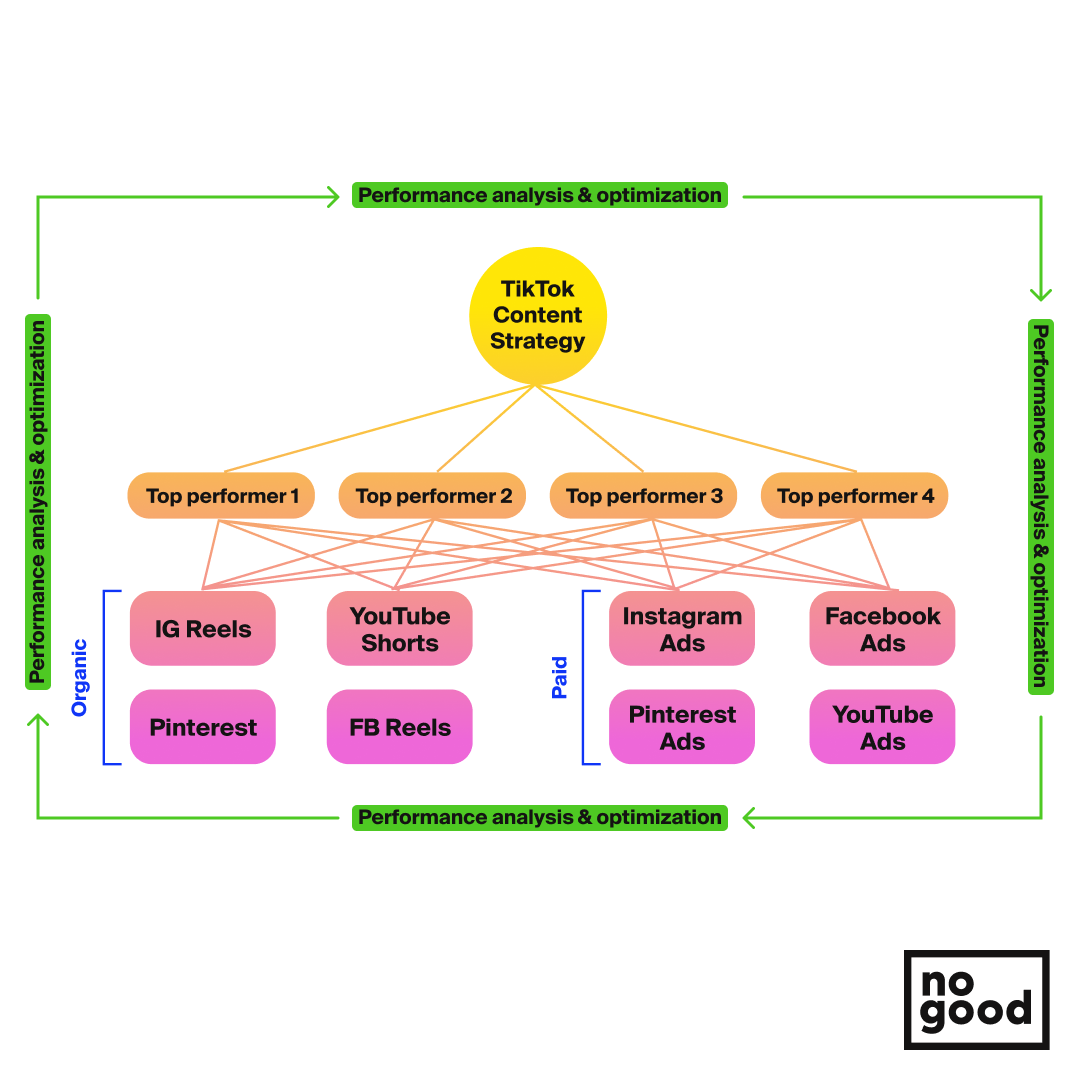
In Short…
TikTok is no longer a platform for teens, dancing, and lipsyncing — it’s quickly emerging as an area of opportunity for brands to create a new touchpoint to reach new audiences, build communities, and drive conversions. Going another day without creating a strong presence on this platform means falling behind — and leaving untapped potential on the table.
That being said, it’s important to really understand the nature of TikTok as a platform driven by authenticity, raw content, entertainment, and consistency in posting if you want to crack the channel’s code for success. No matter your ultimate goal, it’s crucial to dedicate the necessary resources in order to start seeing measurable results and create a new (and sustainable) growth flywheel on the platform. And remember: the North Star here is to create a strong organic presence and build trust with the audience first in order to provide fuel to the fire when it comes to paid TikTok campaigns.
Don’t underestimate the value a TikTok marketing strategy can provide for your brand’s growth — especially in tandem with the rest of the channels in your content marketing arsenal.
